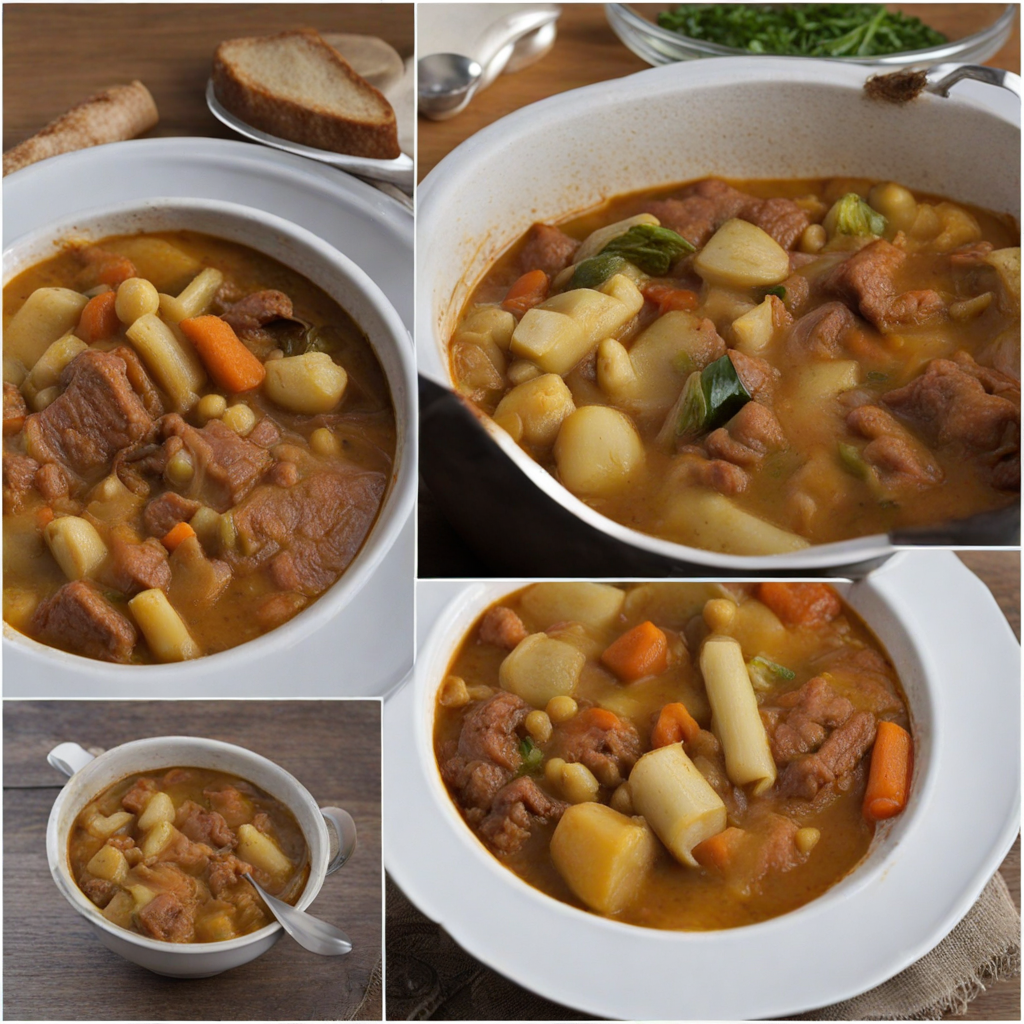Puchero
Puchero is a traditional Argentine stew that embodies the rich culinary heritage of the country, reflecting its diverse cultural influences, particularly from Spain and Italy. Historically, puchero has roots in the communal cooking practices of rural communities, where large pots were used to feed families and workers. It emerged as a practical dish that maximized the use of available ingredients, making it a staple in many Argentine households. Over time, variations of puchero have developed, leading to regional adaptations that highlight local ingredients and preferences. The flavor profile of puchero is robust and hearty, characterized by a deep, savory broth that is infused with the essence of the various ingredients. The dish typically features a balance of flavors from the meat, vegetables, and aromatic herbs, creating a comforting and nourishing meal. The broth is often seasoned with bay leaves, garlic, and peppercorns, providing a fragrant backdrop to the dish. As the ingredients simmer together, they contribute their individual flavors, resulting in a harmonious and satisfying stew. Key ingredients in puchero include a variety of meats, vegetables, and legumes. The meat component usually consists of beef, pork, or chicken, often including cuts such as short ribs, shank, or sausages, which provide richness and depth to the stew. The choice of meat can vary by region, with some variations incorporating more exotic options like lamb. Vegetables typically used in puchero include potatoes, carrots, corn, and cabbage, which add sweetness and texture. In
How It Became This Dish
Origins of Puchero Puchero is a traditional dish that embodies the culinary heritage of Argentina, originating from the diverse cultural influences that have shaped the country's gastronomy. The name "puchero" comes from the Spanish word for "pot," reflecting its preparation method—slow-cooked in a pot. This hearty stew is believed to have roots in the Iberian Peninsula, particularly in regions like Andalusia, where similar dishes have been consumed for centuries. The Spanish settlers brought the concept of the puchero to Argentina in the 16th century, where it began to evolve under the influence of local ingredients and indigenous cooking methods. The earliest versions of puchero were simple, using whatever ingredients were available. The dish typically contained a variety of meats, such as beef, pork, or chicken, along with vegetables like potatoes, carrots, and corn. The cooking technique involved simmering the ingredients together for several hours, allowing the flavors to meld and create a rich, savory broth. Over time, puchero became a staple in Argentine homes, particularly among rural communities, where it represented a practical way to feed large families using minimal resources. \n\n Cultural Significance Puchero holds a special place in Argentine culture, symbolizing comfort, family, and tradition. It is often associated with communal gatherings, where family and friends come together to share a meal. The dish is not only a source of nourishment but also a way to connect with one's heritage. Many Argentine families have their own unique recipes passed down through generations, making puchero a personal and cherished culinary tradition. In addition to its familial significance, puchero is also a reflection of Argentina's diverse cultural landscape. It incorporates elements from indigenous cuisines, Spanish colonial influences, and later Italian and other European immigrants' culinary practices. As a result, the dish varies widely across different regions of Argentina, with each area infusing its local ingredients and flavors into the recipe. For instance, in the northern provinces, puchero may include regional herbs and spices, while in Patagonia, the use of game meats is more common. \n\n Development Over Time As Argentina's culinary scene evolved, so did the preparation and presentation of puchero. In the 19th century, with the influx of immigrants from Europe, the dish began to incorporate new flavors and techniques. Italian and French cooking methods influenced the way puchero was served, leading to the addition of pasta or rice in some variations. This evolution reflects the broader trend in Argentine cuisine, where traditional dishes are often adapted to include international ingredients. The 20th century saw puchero becoming a prominent dish in Argentine cuisine, particularly among the working class. It was a popular option in restaurants and "cantinas," offering a hearty meal at an affordable price. During this time, puchero became associated with rural Argentine culture, often prepared during festivals and family gatherings. Its reputation as a comfort food solidified, making it a go-to dish for celebrations, especially during colder months. In contemporary Argentina, puchero continues to evolve. Chefs and home cooks alike experiment with the dish, introducing modern twists and innovative presentations. While traditional recipes remain beloved, new interpretations have emerged, incorporating ingredients such as quinoa or seasonal vegetables. This adaptability speaks to the resilience of puchero as a dish that can bridge the gap between tradition and contemporary culinary trends. \n\n Regional Variations The beauty of puchero lies in its regional variations, each telling a story of local culture and available ingredients. In Buenos Aires, for instance, puchero is often hearty and meat-heavy, reflecting the city's rich beef culture. The capital's version may include beef brisket, chorizo, and a colorful array of root vegetables, simmered until tender. In contrast, the Andean regions of Argentina may incorporate more indigenous ingredients, such as potatoes and corn, alongside meats like llama or alpaca. This version of puchero highlights the connection to the land and its agricultural bounty, showcasing local produce and traditional cooking methods. The coastal provinces, influenced by the Atlantic Ocean, might include seafood in their puchero, blending the traditional stew with fresh fish and shellfish. The result is a lighter version of the dish, embodying the flavors of the sea while still maintaining the essence of puchero. \n\n Modern Takes on Puchero In recent years, there has been a resurgence of interest in traditional Argentine cuisine, including puchero. Chefs are embracing the concept of "cocina de campo" (country cooking) and are revisiting classic dishes with a contemporary flair. This has led to pop-up restaurants and food festivals celebrating puchero, where chefs showcase their unique interpretations, often emphasizing local and sustainable ingredients. Moreover, puchero has found its way into the global culinary scene, where it is being served in Argentine restaurants around the world. As Argentine cuisine gains recognition internationally, puchero serves as an ambassador of the country's rich culinary heritage, appealing to food enthusiasts eager to explore diverse flavors and culinary traditions. \n\n Puchero in Popular Culture Beyond its culinary significance, puchero has also made its mark in popular culture in Argentina. It appears in literature, film, and music, often symbolizing home, comfort, and nostalgia. The dish is frequently referenced in Argentine novels, where it evokes memories of family gatherings and the warmth of shared meals. Similarly, in Argentine tango music, puchero is sometimes mentioned as part of the fabric of everyday life, further solidifying its status as an emblematic dish. Cooking shows and food documentaries have also played a role in popularizing puchero, showcasing it as a dish that embodies the essence of Argentine culture. These media portrayals highlight not only the preparation of puchero but also the stories behind it, celebrating the connections it fosters among people and generations. \n\n Conclusion As puchero continues to evolve, it remains a beloved dish that connects Argentines to their history, culture, and each other. Its rich flavors and comforting nature make it a staple in homes across the country, while its adaptability ensures that it will remain relevant in Argentina's dynamic culinary landscape. Whether enjoyed in a traditional setting or reimagined in a modern restaurant, puchero is a testament to the enduring power of food as a means of connection and expression of cultural identity.
You may like
Discover local flavors from Argentina







